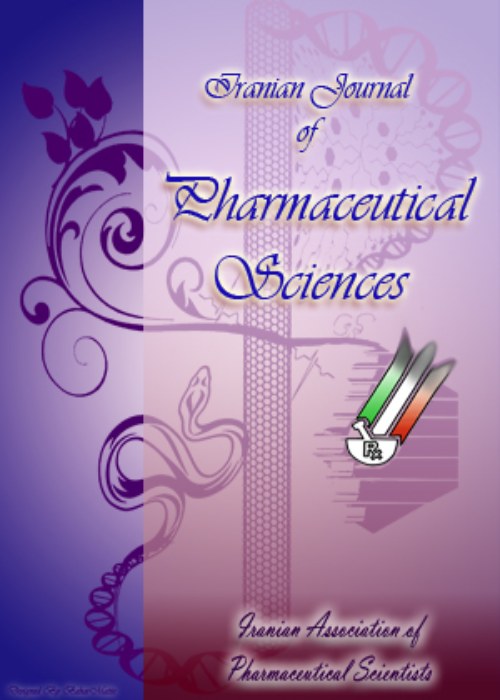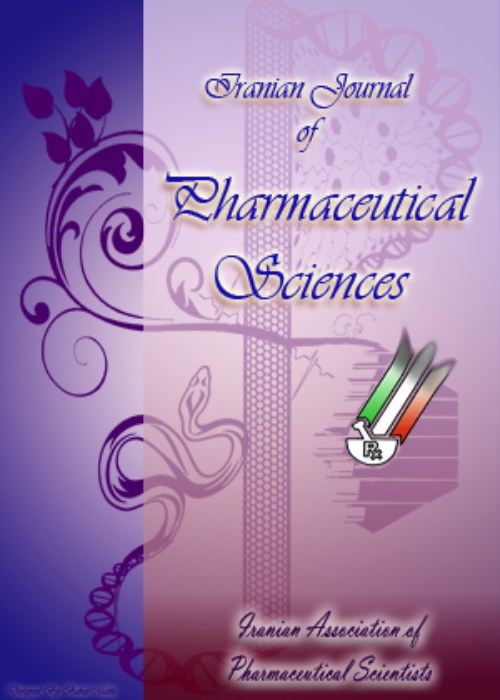فهرست مطالب

Iranian Journal of Pharmaceutical Sciences
Volume:19 Issue: 3, Summer 2023
- تاریخ انتشار: 1402/09/20
- تعداد عناوین: 8
-
-
Pages 188-193
Atorvastatin (ATV) is one of the hyperlipidemia treatment drugs with antioxidant and anti-inflammatory effects, growth differentiation factor 9 (GDF-9) and bone morphogenetic protein 15 (BMP-15) are two potent regulator factors of ovulation. This study investigated the effect of atorvastatin on GDF-9 and BMP-15 expression and explores its relationship with oocyte maturation in mice. A total of 200 oocytes from 40 mice were collected and divided into two groups (n=100 in each group), including the control group and the atorvastatin group (receiving 2 mg/kg atorvastatin). After oocyte culture in DMEM medium, GDF-9, and BMP-15 expression were evaluated by Real-time PCR. The rate of oocyte maturation was evaluated using fluorescent microscope scanning. Data were analyzed using an ANOVA test. GDF-9 and BMP-15 expression in control and atorvastatin groups were 2.3 and 4.8 (P≤0.05) and 1.2 and 3.4 fold respectively (P≤0.001). The oocyte maturation rate in the atorvastatin and control groups was 82% and 76%, respectively (p>0.05). According to our findings, low-dose atorvastatin caused overexpression of GDF-9 and BMP-15 in mice oocytes and it could improve the quality and maturation of mouse oocytes.
Keywords: Atorvastatin, GDF-9, BMP-15, Oocyte -
Pages 194-207
The prednisolone was very slightly soluble in water. It was a curative agent against oral recurrent aphthous stomatitis. The main objective of this study is to design, prepare, and evaluate a hybrid nanogel of prednisolone as a topical dosage form to increase prednisolone solubility, stability, and therapeutic activity. The microwave-based method prepared nine prednisolone lipid polymer hybrid nanocarriers LPHNs formulations (H1-H9). The conventional prednisolone gel (G) was prepared by solvent diffusion. The H1-H9 was evaluated thermodynamically and entered into characterization processes. The hybrid nanogels HN1-HN9 formulations were tested for various evaluations. All the H1-H9 formulations showed high thermodynamic stability and nanosized globules, low polydispersity index, acceptable surface charge, entrapment efficiency, and drug loading. The evaluation processes indicate stable organoleptic properties, high homogeneity, fair pH and spreadability coefficient values with plastic viscosity and no erythemic reaction. The profile of prednisolone release and permeability coefficient (cm/min) was significantly higher (p-value <0.05) for HN3 and significantly lower (p-value < 0.05) for conventional prednisolone gel (G). The optimized HN1-HN9 formulations were promised drug delivery systems for treating recurrent aphthous stomatitis and a wide variety of oral lesions in addition to local and transdermal delivery of various therapeutic agents and cosmetics.
Keywords: Recurrent aphthous stomatitis, Microwave-based method, Prednisolone, Chitosan, Cardamom oil, Topical pharmaceutical dosage form -
Pages 208-216
Regarding the unpleasant pain sensation and the public’s desire to use traditional herbs, the present study aimed to assess the analgesic and anti-inflammatory effect of Chenopodium botrys L. The present research was divided into two main sections to assess the analgesic and anti-inflammatory effect of Chenopodium botrys L. in male mice. To investigate the analgesic effect of Chenopodium botrys L., thirty-six male mice were randomly classified into six groups vehicle (receiving normal saline), experimental groups received morphine (a well-known opioid, 1 mg/kg), hydroalcoholic extracts of Chenopodium botrys L. (30, 100, and 300 mg/kg), and naloxone (opioid receptor antagonist) with the highest dose of Chenopodium botrys L. concurrently for one week. Thirty mice were divided into five groups to receive normal saline, various doses of extract (30, 100, and 300 mg/kg), and dexamethasone (a well-known anti-inflammatory drug, 10 mg/kg) to assess the anti-inflammatory effect of Chenopodium botrys L. In both sections, after the last doses of the treatment, the animals got ready for behavioral study related to pain. Overall, the highest doses of Chenopodium botrys L. demonstrated much better results than other doses, which were comparable to opioids and dexamethasone, a well-known analgesic and anti-inflammatory medicines, respectively. Regarding present findings, the Chenopodium botrys L. plant can be a new candidate as an analgesic agent, which needs more investigation in the search and pharmaceutical development.
Keywords: Chenopodium botrys, analgesia, pain, mice, opioid -
Pages 217-227
From two classes of Bacteroides fragilis, enterotoxigenic B. fragilis (ETBF) is associated with colorectal cancer (CRC), yet several non-toxigenic B. fragilis (NTBF) confers powerful health benefits to the host and may be potential probiotic. In this study, the HT-29 cell line was treated with the supernatant of NTBF strain ATCC-23745. Then, the expression level of mTOR /p62/Caspase8/Bax proposed signaling pathway and cell viability, cell apoptosis, and cell cycle progression were determined using Real-time PCR and flow cytometry, respectively. We found that the B. fragilis supernatant inhibited cell proliferation and increased cell apoptosis in a dose- and time-dependent manner. Further, the arrest of the HT-29 cells at the G1 and sub-G1 phases also signified apoptotic cell death after 24 and 72h. The gene expression study revealed that the supernatant significantly up-regulated the Caspase8/Bax/Fas-mediated apoptosis signaling while suppressing the anti-apoptotic mTOR and p62 expression. Our findings suggest that the NTBF ATCC-23745 strain may be a potential probiotic and can be used in CRC treatment.
Keywords: Apoptotic death, Colorectal cancer, Next generation probiotic, Nontoxigenic Bacteroides fragilis, Signaling pathway -
Pages 228-237
DOX therapy as an anticancer agent by incorporation of either physical treatments or antioxidant supplementation. Curcuma zedoaria (Rosc) (family Zingiberaceae) is an indigenous plant with antioxidant and anticarcinogenic activity. This study investigates the potential protective activities of an ethanol extract from Curcuma zedoaria (CZE) against DOX toxicities on non-target organs. A total of 50 female Wistar rats were divided into five groups: control group (G1), DOX only (G2), CZE 350 mg/kg + DOX (G3), CZE 525 mg/kg + DOX (G4), and Vit E + DOX (G5). Daily administration of CZE was given intra-gastric for 30 days, while 5 mg/kg DOX was injected concomitantly each on days 7, 14, and 21. The results of blood biochemical analysis indicated that administration of either the single or multiple doses of DOX (G2) caused significant elevation in the blood levels of alanine aminotransferase (ALT), aminotransferase (AST), creatinine, and CK-MB, indicating that the tissue damages occurred in the liver, kidney, and heart. Treatments with CZE demonstrated that ALT, AST, creatinine, and CK-MB levels remained similar to baseline levels, or no elevation was observed in all groups (G3 and G4). The oral administration of CZE in doses of 350 mg/kg and 525 mg/kg also decreased the AST/ALT ratio independent of the dose given. However, 350 mg/kg CZE indicated a faster response to protecting activities than other treatments. In conclusion, administration of a Curcuma zedoaria (Berg.) Roscoe ethanol extract, particularly in the 350 mg/kg dose, can potentially prevent or reduce DOX's toxicities in the liver, kidney, and cardiac cells.
Keywords: Curcuma zedoaria, Doxorubicin, Protective, Toxicities -
Pages 238-249
Arbutus serratifolia Salisb. is known as a strawberry tree belonging to the Ericaceae family and represents a Mediterranean evergreen shrub. The species distributed in the forest of El Milia region (Jijel) was chosen as a specimen for chemical investigation and biological evaluation for the first time from this region. The MeOH extract of the aerial parts underwent qualitative phytochemical screening using conventional techniques. While CHCl3, EtOAc, n-BuOH, and even MeOH fractions were subjected to quantitatively determine the total phenolic and flavonoid contents using the Folin-Ciocalteu and Aluminium trichloride methods respectively. The antioxidant potential of these fractions was assessed using the DPPH scavenging activity, ABTS cation radical reduction, CUPRAC reducing capacity and Phenanthroline assays. This study revealed that A. serratifolia Salisb. fractions are endowed with potent antioxidant activity; thus, it is worth noting that this plant could be used as a rich food source for a wide range of phenolic compounds, particularly of new antioxidant agents.
Keywords: Arbutus serratifolia Salisb, Phytochemical screening, Phenolic compounds, Flavonoid contents, Scavenging power, Radical reduction -
Pages 250-260
This study applied the transcriptomic-based bioinformatics analysis to systematically integrate data on risk loci for malaria biology and drug discovery from various databases. It was hypothesized that genomic-driven drug repurposing can be utilized as an alternative approach for malaria drug repurposing. Herein, transcriptomic profiles were extracted and retrieved from the NCBI-GEO website by using the keywords "malaria" and "Homo sapiens". In sum, the data mining analysis for malaria drug targets was conducted by integrating the three datasets, including GSE33811, GSE7586, and GSE5418. Limma package was used to detect differentially expressed genes (DEGs). The following cut-off criteria were used for screening DEGs: [log fold change (logFC)] > 1 and p-value < 0.05. This study employed a scoring system with seven criteria called functional annotations to prioritize the risk gene candidates for malaria. Following the scoring system, a score of> 2 was identified as a malaria biological risk gene. Overlapping analyses between gene target candidates and drug candidates were conducted using the DrugBank database to obtain new drug targets for malaria. Eighty drug-target genes were identified in this study, but only five genes exhibited druggability and overlapped with the targets of existing drugs, thereby presenting a potential avenue for malaria drug repurposing. These genes, namely PSMB2, CXCR4, ITGA4, RAF1, and PTGER3, hold promising prospects for malaria therapy. Interestingly, five genes were overlapped with 12 drug candidates (Sorafenib, Regorafenib, Dabrafenib, Natalizumab, Vedolizumab, Bimatoprost, Dinoprostone, Misoprostol, Gemeprost, Castor oil, Carfilzomib, and Plerixafor). In conclusion, an in-silico drug screening system not only can identify the biological risk genes but also potential to drives malaria drug repurposing.
Keywords: CXCR4, Drug repurposing, ITGA4, Malaria, PSMB2, PTGER3, Transcriptomics, RAF1 -
Pages 261-278
Self-medication, a universal public health issue, is an increasingly common concern. A meta-analysis of global self-medication patterns will be worthwhile for a comprehensive yet comparative consideration of the burden and related problems and planning for macro-health interventions and policies. This study aimed to determine the patterns of self-medication and drug storage behavior globally in various subgroups and its related factors. A systematic search detected relevant studies (1995 to 2018) in the English databases. The related observational study was concluded in this study. Studies that examined self-medication and drug storage at home in the general population were entered into the study. The pooled proportion and odds ratio of self-medication and drug storage at home were calculated by STATA -14. Of 25’225 titles found, 95 studies were included in the final analysis. The pooled prevalence of self-medication was calculated at 54.0% ±4.0% (60% for over-the-counter (OTC) drugs and 43.0% for prescription-only medicines (POM) drugs). The pooled prevalence of drug storage at home was estimated to be 53.0% (CI 95%: 36.0, 70.0). The proportion of self-medication and drug storage at home in continents was: Africa 64.0% and 39.0%, Asia 58.0% and 64.0%, Europe 39.0% (both), and America 32.0% and 8.0%, respectively. African countries had the highest consumers of POM drugs as well as antibiotics. Pharmacists provided the most information about drugs in African studies. The adjusted odds ratio of self-medication was higher in females with higher education status in European and African countries. The prevalence of self-medication for POM drugs was noteworthy, especially in Asian and African countries. Comprehensive education for pharmacists must be accomplished. Also, increasing drug information is critical for women who usually manage family health in households.
Keywords: Self-medication, Drug storage, Over-the-counter drugs, Prescription-only medicines, Antibiotics, Meta-analysis


